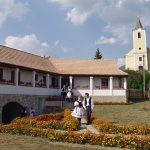Kazár, Comitat Salgótarján, Hungary
The municipality Kazár lies in the administrative area of the comitatus Salgótarján in northern Hungary that with the neighbouring comitatus Eger and Miskolc makes up the region Nógrád. Kazár today has 2,145 inhabitants with a solid age distribution and slightly declining population development. Embedded in the foothills of the Matra mountains the surrounding landscape is characterised by meagre forest and meadow areas.
Due to the unsuitable ground for intensive farming use, farming has lost its importance as a job provider over the last few decades. The property of the state production collective was completely privatised in 1990. The Agrokazár Co. Ltd. became the successor and leases on long term about half of the privatised area and farms it conventionally (cattle breeding). On the remaining 50 percent of the agricultural area two full-time and 15 part-time farmers farm biologically also increasingly in conjunction with later added value by refining and processing the agricultural products.
The main employer of the village was until the end of the seventies the six mines in the area that mined brown coal. Alongside a self confident enterprise of handcraft, trade and industrial small and tiny businesses developed. Since the loss of mining the comitatus capital, Salgótarján, eight kilometres away, attracts a large part of the working population. The slump in the dominating metal industry there at the beginning of the nineties resulted in an economic depression with high unemployment and emigration.
In 1996 Kazár started a village renewal programme and since 2003 it takes part in a LEADER programme within a micro region of in total eleven neighbouring municipalities. The basic idea of the village renewal plan was a return to the historical and cultural heritage, and an improvement of the job situation, service provision, building infrastructure and schooling.
To secure empty historical buildings and thus preserve, respectively restore, the expressive and for the community identity creative village image, the municipality acquired several objects typical for the ethnic group (Palocze) rural architecture, renovated them and gave them public functions (museums, citizen’s hall, service centre etc.) In the granary a new centre for village life, the civil hall, was set up. There clubs and NGOs found new meeting rooms and the municipal information office, the telecommunications office with several internet work stations and the tourist office a common location.
As a counterpart to the civil hall a service and health house was created in the old school which expanded the medical and social provision in the village. To improve schooling Kazár entered into a school alliance with four neighbouring municipalities and established a communal primary school with 370 pupils in its own village. The school network was later enlarged by an affiliate school for 100 pupils in a neighbouring village twelve kilometres away. A similar commitment to a village spanning network is shown in the work of the club for land development and social care.
To counteract emigration and unemployment the municipality started a campaign to settle small industrial and trade companies. As a result the number of companies rose from 43 to 74. A total of 218 people work in the village. Kazár is trying to position itself as a historically, scenic, sport and leisure interesting tourist attraction and so activate the development of another branch of trade. The regional connection to Kazár was improved by the development of the regional road network. The local road works are also intact. All buildings have a sewage connection and the municipal garbage removal network.
The municipality of Kazár has succeeded in important developments since the start of the village renewal process. Above all the contribution to the cultural identification of the village community, numerous renovations and revitalizations, the willingness for regional cooperation and the creation of contemporary facilities to improve the quality of life should be underlined. Also the measures for economic new orientation and positioning of the village show proper tendencies and are beginning to take effect.
Evaluated: 2008




